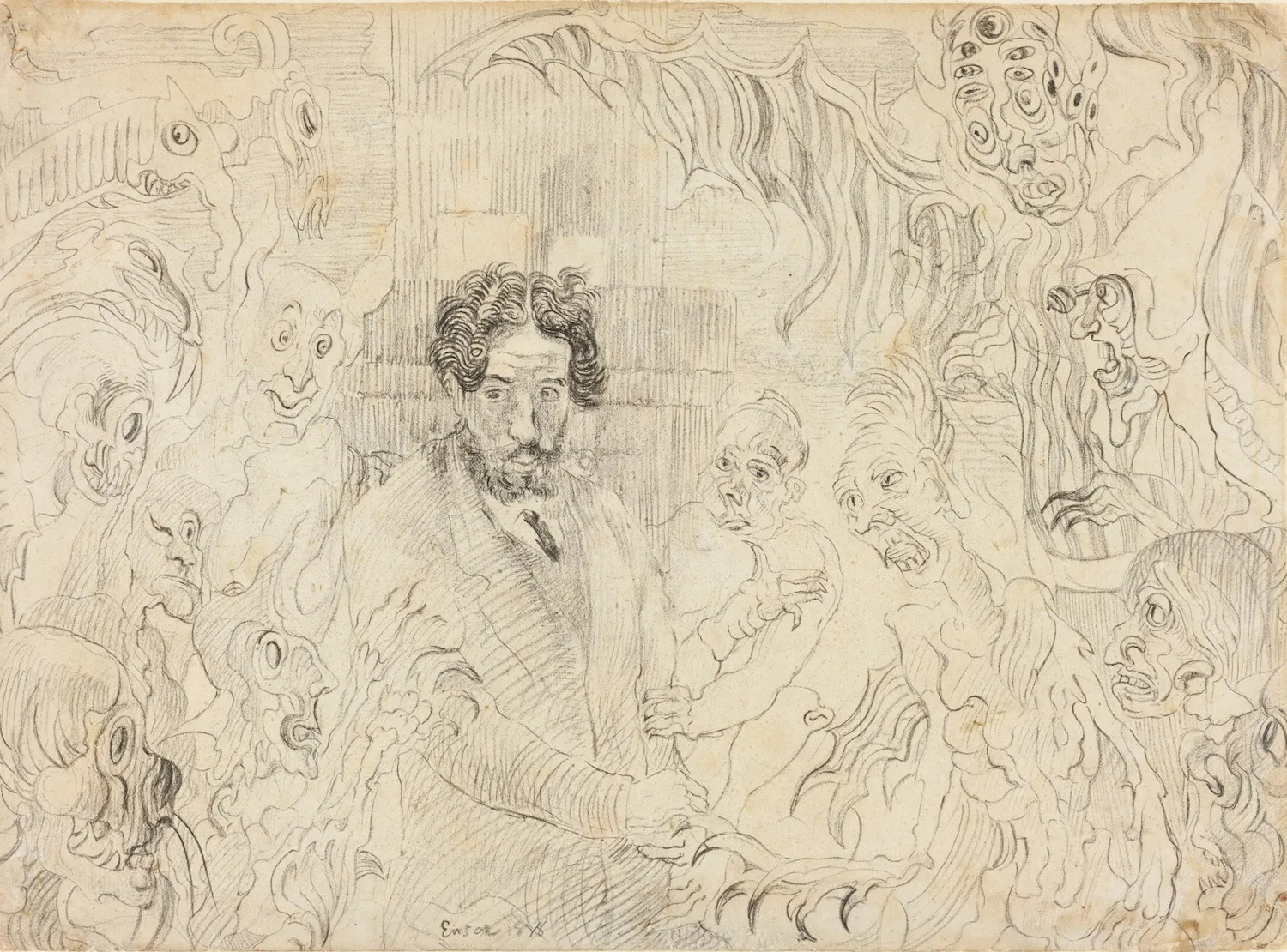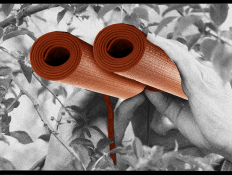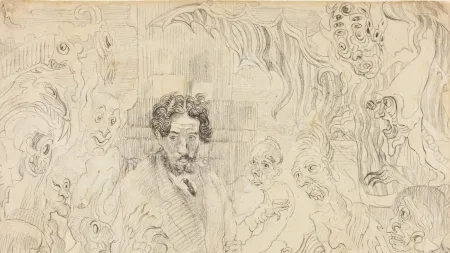
Sitting on the Flemish coast, the city of Ostend in Belgium overlooks the English Channel, its miles of beaches making it a popular seaside resort since the first half of the 19th century. It’s also known for a yearly carnival attracting masked revelers whose presence lends a macabre air to Ostend’s otherwise picturesque character—which, in any case, conceals an oft violent past.
Originally settled in the early Middle Ages, Ostend became a fortified stronghold during the 15th century thanks to a vital maritime location that made it a flash point of conflict. Between 1601 and 1604, the town was besieged by Spain during Holland’s rebellion against the Hapsburg crown, with cannonades hurled daily against its walls. The dead on both sides totaled six figures, leaving human remains that were still being discovered well into the 20th century.
Adding to the body count, an explosion at a local ammunition dump in 1827 left dozens of casualties. During World War I a German U-boat base in Ostend was assaulted by the Royal Navy, and in World War II Britain rained incendiary bombs on the city when it was once again occupied by Germany.
It wouldn’t be an exaggeration, then, to say that Ostend has been a stately bourgeois pleasure dome haunted by the dead, its dark undercurrent very much suffusing the art of its most illustrious son, the painter James Ensor (1860–1949).
A contemporary of both the Post-Impressionists and the Symbolists, Ensor didn’t fit into either category, being instead a precursor of two of the 20th-century’s most important and influential movements: Expressionism and Surrealism. Ensor transformed Charles Baudelaire’s call to paint modern life into a kind of Twilight Zone of the Belle Epoque, where corruptions of spirit and flesh, imminent mortality, and eschatological forebodings of the future were ever present.
One can see as much in Ensor’s sardonic 1888 etching My Portrait in 1960, in which he depicts himself as a supine skeleton, moldering on the ground on the centenary of his birth. While he called the image a “simple anticipation” of his ultimate destiny, it seems more than serendipitous that the date corresponds to the height of cold war fears about nuclear Armageddon. In this piece Ensor could be said to be both literally and figuratively ahead of his time, and the same was true of the rest of his oeuvre.
This year marks 75 years since the artist’s death at 89, an anniversary being celebrated by several Ensor exhibitions, including a major survey that recently opened at the Royal Museum of Fine Arts in Antwerp (through January 19, 2025). Given the occasion, the time is ripe to revisit Ensor’s place in art history and the ways in which he shaped it.
ENSOR 2024 shows this fall:
“Ostend, Ensor’s Imaginary Paradise,” the Venetian Galleries, Ostend, through October 27, 2024.
“James Ensor: Satire, Parody, Pastiche,” James Ensor House, Ostend, through January 12, 2025.
“Ensor’s Wildest Dreams,” KMSKA, Antwerp, through January 18, 2025
“Masquerade, Makeup & Ensor,” MoMu, Antwerp, through February 2, 2025
“Cindy Sherman: Anti-Fashion” FOMU, Antwerp, through February 2, 2025
-
Early life and career

Image Credit: Collection of the Hamburger Kunsthalle, Hamburg, Germany. Photo: Elke Walford. Digital image Hamburger Kunsthalle/Art Resource, New York. Artwork copyright © 2024 Artists Rights Society (ARS), New York. Born James Sidney Ensor, the artist suffered through a troubled childhood. His father, James Frederic Ensor, was a British engineer who’d married a local woman named Maria Catherina Haegheman. A foreigner who was largely unemployed and mentally unstable due to alcoholism and heroin addiction, James Sr. was treated with suspicion by his neighbors.
The junior Ensor had to take care of a mother who was often ill and was himself a persistent hypochondriac. Acerbic, with a jaundiced view of the human condition, Ensor largely kept to himself. He exhibited a tendency toward self-loathing, once describing himself as “nasty, wicked, incapable, ignorant, a creampuff gone rotten.” All of these traits found their way into his art.
Nonetheless, Ensor took a leadership role within the Belgian avant-garde. He was a founding member of Les XX, a group of 20 Belgian artists who organized and exhibited their work in opposition to the official Antwerp Salon—which, among other things, had rejected Ensor’s painting The Oyster Eater for its 1882 edition. Though far more conventional than the work Ensor would become known for, this depiction of a young woman enjoying shellfish was deemed too sexually suggestive by the selection committee; its disapproval would be a harbinger of the negative reaction that Ensor’s work received for much of his career.
Except for three years spent in Brussels studying at the Academy of Fine Arts and a few sojourns to Paris, London, and the Netherlands, Ensor never left his parents’ house. His bedroom on the fourth floor also served as his studio. At street level, a gift emporium run by his mother offered an assortment of seashells, corals, dolls, and, most importantly for Ensor’s art, masks sold to tourists at carnival time. Garish and grotesque, these objects were exploited in Ensor’s work for their uncanny qualities and became a defining feature of his art. To Ensor, masks were both quotidian and disruptive of the everyday, embodying “wild unexpected gestures . . . shrill expressions, [and] exquisite turbulence.”
The shop also inspired his use of color. “I spent my childhood . . . surrounded by curiosities from the sea,” he once said. “The proximity of these wonders, the colors, this light-filled, gleaming opulence undoubtedly helped turn me into a painter . . . sensitive to the dazzling play of light.” That much is evident in Ensor’s still life Shells and Shellfish (1889), which features a tabletop tableau of radiant marine marvels dominated by a conch shell rendered in fleshy hues.
-
Style and subject matter

Image Credit: Collection of the Musées Royaux Des Beaux-Arts De Belgique in Brussels. Artwork copyright © 2024 Artists Rights Society (ARS), New York. Ensor’s palette was consistent with Post-Impressionism, which infiltrated his facture as well. Taking a page from Paul Cezanne, Ensor employed faceted brushstrokes, though he made them broader and more emotive than Cezanne’s precise, chisel-like marks. The latter’s chromatic schemes also tended to be naturalistic: Apples looked like apples, and mountains like mountains. Ensor, on the other hand, used bright blues and pinks to frame scenes filled with outlandish characters. In Skeletons Fighting Over a Pickled Herring (1891), for instance, two skulls—one wearing a hussar’s busby—face each other with their jaws clamped on opposite ends of the fish in a comical tug-of-war. The image’s intimations of war and famine are made all the more disquieting by Ensor’s choice of a frothy pastel backdrop.
The bleak irony of Skeletons Fighting points to yet another key aspect of Ensor’s practice: its satirical edge. Ensor was anti-authoritarian by nature, another trait comporting with a misanthropy that by his own admission was more British than Belgian in tone. He compared his penchant for eviscerating society’s foibles to William Hogarth’s, to which one might add the Georgian Era political cartoonist Thomas Rowlandson, whose japes at the great and good were especially kindred to works like Ensor’s The Bad Doctors (1892).
Setting the composition against an expanse of pale turquoise, Ensor here portrays utter carnage in an operating theater as a never-ending tapeworm is being extracted from the abdomen of a hapless patient in excruciating pain (who some have suggested is Ensor himself). A pair of decomposing corpses in a window overlooking the room, plus the figure of death in the doorway, watch as five physicians wantonly violate their Hippocratic oath to do no harm. Two of them wear top hats, while the others are dressed in surgical smocks, one of them covered in gore.
All of these worthies were based on real members of the faculty of medicine at the Free University of Brussels, though Ensor had never met any of them. The point, of course, was that they represented one of the many self-satisfied elites whom Ensor held in contempt—along with clergymen, judges, lawyers, and, as one might expect, art critics.
-
Life on the Margins

Image Credit: Collection of the J. Paul Getty Museum, Los Angeles. Digital image courtesy of the J. Paul Getty Museum. Artwork copyright © 2024 Artists Rights Society (ARS), New York. Ensor’s disdain for humanity, however, extended beyond the elect to people overall, an attitude that reaches its apocalyptic apogee in his massive (8- by 14-foot) 1888 masterpiece, Christ’s Entry Into Brussels in 1889. With the title setting the action in the year following the canvas’s completion, Christ’s Entry transposes Jesus’s triumphal arrival in Jerusalem on Passover eve to the Belgian capital, reimagining it as a Mardi Gras procession—a disorderly mob of heads bobbing in a sea of gaudy disguises.
Chaos reigns within an overwhelming rush of caricatures that include members of Ensor’s family, along with public officials and figures both allegorical and historical (among them the Marquis de Sade). Ensor paints himself as the tiny figure of Christ in the center of the composition, suggesting his suffering as an overlooked artist while indulging his usual self-mockery. The crowd before him—carrying signs and banners reading “LONG LIVE THE SOCIAL” and “JESUS, KING OF BRUSSELS—pushes against the picture plane, threatening to trample the viewer.
However self-imposed at times, Ensor’s marginalization was real enough: His own peers within Les XX declined to include Christ’s Entry in one of its expositions. Ensor kept it in his studio, occasionally showing it to visitors, but its public debut didn’t occur until 1929 at the Centre for Fine Arts, Brussels, where its lurid color scheme and troweled-on pigments revealed it as a forerunner of Expressionism.
Behind many of Ensor’s eerie allegories was the fact that as a formal matter, they were often grounded in reality. Many of his monstrosities were simply combinations of props—masks, costumes, skulls—posed and painted from life. They were essentially still life setups in ghastly figurative form. Masks Confronting Death (1888) is a prime example. An apparitional assemblage of the titular items combined with swaths of fabric crowd around an effigy of the grim reaper—just a cranium, really, wearing a woman’s hat with a large white napkin-like cloth shoved under his chin like a diner at an Italian restaurant. Several of the characters have large noses as if sniffing him out, and one wears a pair of blue-tinted spectacles, adding a touch of cool malice. The painting could be seen as Ensor’s bid to stall mortality, even though he knows it’s a losing proposition.
Ensor created a series of paintings in a similar vein at the end of the 1880s, with Skeletons Warming Themselves (1889) regarded as another of his most important achievements. It is, like much of Ensor’s production, a form of vanitas, presented here to suggest a play frozen mid-scene, with the actors mysteriously dissipated, leaving only bones and apparel behind. They’re gathered around an unlit stove, scrawled with the words “No fire. Will you find any tomorrow?” The interior is depicted as a studio with a painter’s palette, a violin, and a writer’s lamp lying about, presumably as symbols of art, music, and literature, marking the image as a meditation on the death of creativity—and more pointedly, a dearth of patronage.
-
Late Success

Image Credit: Collection of the Metropolitan Museum of Art, New York. Digital image copyright © The Metropolitan Museum of Art. Image source: Art Resource, New York. Artwork copyright © 2024 Artists Rights Society (ARS), New York. Ensor’s lack of money and critical support were a consistent worry. He was constantly hard up, though his considerable printmaking output enabled him to pay his bills with etchings and engravings in lieu of cash. At one point he attempted to sell the entire contents of his studio for a sum that was absurdly low considering the prolific extent of his production.
After the turn of the 20th century, however, Ensor began to enjoy acclaim as an éminence grise of Belgian art. A decade on from his most important work, he became something of a celebrity, organizing an annual masquerade, the Bal du Rat Mort (“Ball of the Dead Rat”), in 1898, which remains part of Ostend’s carnival. By 1933 Ensor’s reputation had become such that he got to meet Albert Einstein, who tried to explain his theory of relativity to the artist to no avail. When Einstein asked him what he painted, Ensor replied, “Nothing.”
Almost proportionally to his growing fame, however, Ensor’s art began to decline in both quality and quantity. Without an engine of alienation, it seemed, the work sputtered to a halt. In any case, Ensor never achieved the recognition of his fellow purveyor of northern European angst, the Norwegian Edvard Munch, perhaps because Ensor’s blend of self-laceration and humor seemed unserious in comparison with works like Munch’s The Scream. In this respect, Ensor remained something of an artist’s artist, even as his position within the chronicles of art history was secured.
Among the ghouls populating his work, Ensor made himself first among equals with self-portraits showing him in varying states of decomposition. But in his oeuvre, the particular is made universal, exhuming the horrors of past and present, along with those that would disastrously come to pass in the century to come.
Early life and career

Born James Sidney Ensor, the artist suffered through a troubled childhood. His father, James Frederic Ensor, was a British engineer who’d married a local woman named Maria Catherina Haegheman. A foreigner who was largely unemployed and mentally unstable due to alcoholism and heroin addiction, James Sr. was treated with suspicion by his neighbors.
The junior Ensor had to take care of a mother who was often ill and was himself a persistent hypochondriac. Acerbic, with a jaundiced view of the human condition, Ensor largely kept to himself. He exhibited a tendency toward self-loathing, once describing himself as “nasty, wicked, incapable, ignorant, a creampuff gone rotten.” All of these traits found their way into his art.
Nonetheless, Ensor took a leadership role within the Belgian avant-garde. He was a founding member of Les XX, a group of 20 Belgian artists who organized and exhibited their work in opposition to the official Antwerp Salon—which, among other things, had rejected Ensor’s painting The Oyster Eater for its 1882 edition. Though far more conventional than the work Ensor would become known for, this depiction of a young woman enjoying shellfish was deemed too sexually suggestive by the selection committee; its disapproval would be a harbinger of the negative reaction that Ensor’s work received for much of his career.
Except for three years spent in Brussels studying at the Academy of Fine Arts and a few sojourns to Paris, London, and the Netherlands, Ensor never left his parents’ house. His bedroom on the fourth floor also served as his studio. At street level, a gift emporium run by his mother offered an assortment of seashells, corals, dolls, and, most importantly for Ensor’s art, masks sold to tourists at carnival time. Garish and grotesque, these objects were exploited in Ensor’s work for their uncanny qualities and became a defining feature of his art. To Ensor, masks were both quotidian and disruptive of the everyday, embodying “wild unexpected gestures . . . shrill expressions, [and] exquisite turbulence.”
The shop also inspired his use of color. “I spent my childhood . . . surrounded by curiosities from the sea,” he once said. “The proximity of these wonders, the colors, this light-filled, gleaming opulence undoubtedly helped turn me into a painter . . . sensitive to the dazzling play of light.” That much is evident in Ensor’s still life Shells and Shellfish (1889), which features a tabletop tableau of radiant marine marvels dominated by a conch shell rendered in fleshy hues.
Style and subject matter

Ensor’s palette was consistent with Post-Impressionism, which infiltrated his facture as well. Taking a page from Paul Cezanne, Ensor employed faceted brushstrokes, though he made them broader and more emotive than Cezanne’s precise, chisel-like marks. The latter’s chromatic schemes also tended to be naturalistic: Apples looked like apples, and mountains like mountains. Ensor, on the other hand, used bright blues and pinks to frame scenes filled with outlandish characters. In Skeletons Fighting Over a Pickled Herring (1891), for instance, two skulls—one wearing a hussar’s busby—face each other with their jaws clamped on opposite ends of the fish in a comical tug-of-war. The image’s intimations of war and famine are made all the more disquieting by Ensor’s choice of a frothy pastel backdrop.
The bleak irony of Skeletons Fighting points to yet another key aspect of Ensor’s practice: its satirical edge. Ensor was anti-authoritarian by nature, another trait comporting with a misanthropy that by his own admission was more British than Belgian in tone. He compared his penchant for eviscerating society’s foibles to William Hogarth’s, to which one might add the Georgian Era political cartoonist Thomas Rowlandson, whose japes at the great and good were especially kindred to works like Ensor’s The Bad Doctors (1892).
Setting the composition against an expanse of pale turquoise, Ensor here portrays utter carnage in an operating theater as a never-ending tapeworm is being extracted from the abdomen of a hapless patient in excruciating pain (who some have suggested is Ensor himself). A pair of decomposing corpses in a window overlooking the room, plus the figure of death in the doorway, watch as five physicians wantonly violate their Hippocratic oath to do no harm. Two of them wear top hats, while the others are dressed in surgical smocks, one of them covered in gore.
All of these worthies were based on real members of the faculty of medicine at the Free University of Brussels, though Ensor had never met any of them. The point, of course, was that they represented one of the many self-satisfied elites whom Ensor held in contempt—along with clergymen, judges, lawyers, and, as one might expect, art critics.
Life on the Margins

Ensor’s disdain for humanity, however, extended beyond the elect to people overall, an attitude that reaches its apocalyptic apogee in his massive (8- by 14-foot) 1888 masterpiece, Christ’s Entry Into Brussels in 1889. With the title setting the action in the year following the canvas’s completion, Christ’s Entry transposes Jesus’s triumphal arrival in Jerusalem on Passover eve to the Belgian capital, reimagining it as a Mardi Gras procession—a disorderly mob of heads bobbing in a sea of gaudy disguises.
Chaos reigns within an overwhelming rush of caricatures that include members of Ensor’s family, along with public officials and figures both allegorical and historical (among them the Marquis de Sade). Ensor paints himself as the tiny figure of Christ in the center of the composition, suggesting his suffering as an overlooked artist while indulging his usual self-mockery. The crowd before him—carrying signs and banners reading “LONG LIVE THE SOCIAL” and “JESUS, KING OF BRUSSELS—pushes against the picture plane, threatening to trample the viewer.
However self-imposed at times, Ensor’s marginalization was real enough: His own peers within Les XX declined to include Christ’s Entry in one of its expositions. Ensor kept it in his studio, occasionally showing it to visitors, but its public debut didn’t occur until 1929 at the Centre for Fine Arts, Brussels, where its lurid color scheme and troweled-on pigments revealed it as a forerunner of Expressionism.
Behind many of Ensor’s eerie allegories was the fact that as a formal matter, they were often grounded in reality. Many of his monstrosities were simply combinations of props—masks, costumes, skulls—posed and painted from life. They were essentially still life setups in ghastly figurative form. Masks Confronting Death (1888) is a prime example. An apparitional assemblage of the titular items combined with swaths of fabric crowd around an effigy of the grim reaper—just a cranium, really, wearing a woman’s hat with a large white napkin-like cloth shoved under his chin like a diner at an Italian restaurant. Several of the characters have large noses as if sniffing him out, and one wears a pair of blue-tinted spectacles, adding a touch of cool malice. The painting could be seen as Ensor’s bid to stall mortality, even though he knows it’s a losing proposition.
Ensor created a series of paintings in a similar vein at the end of the 1880s, with Skeletons Warming Themselves (1889) regarded as another of his most important achievements. It is, like much of Ensor’s production, a form of vanitas, presented here to suggest a play frozen mid-scene, with the actors mysteriously dissipated, leaving only bones and apparel behind. They’re gathered around an unlit stove, scrawled with the words “No fire. Will you find any tomorrow?” The interior is depicted as a studio with a painter’s palette, a violin, and a writer’s lamp lying about, presumably as symbols of art, music, and literature, marking the image as a meditation on the death of creativity—and more pointedly, a dearth of patronage.
Late Success

Ensor’s lack of money and critical support were a consistent worry. He was constantly hard up, though his considerable printmaking output enabled him to pay his bills with etchings and engravings in lieu of cash. At one point he attempted to sell the entire contents of his studio for a sum that was absurdly low considering the prolific extent of his production.
After the turn of the 20th century, however, Ensor began to enjoy acclaim as an éminence grise of Belgian art. A decade on from his most important work, he became something of a celebrity, organizing an annual masquerade, the Bal du Rat Mort (“Ball of the Dead Rat”), in 1898, which remains part of Ostend’s carnival. By 1933 Ensor’s reputation had become such that he got to meet Albert Einstein, who tried to explain his theory of relativity to the artist to no avail. When Einstein asked him what he painted, Ensor replied, “Nothing.”
Almost proportionally to his growing fame, however, Ensor’s art began to decline in both quality and quantity. Without an engine of alienation, it seemed, the work sputtered to a halt. In any case, Ensor never achieved the recognition of his fellow purveyor of northern European angst, the Norwegian Edvard Munch, perhaps because Ensor’s blend of self-laceration and humor seemed unserious in comparison with works like Munch’s The Scream. In this respect, Ensor remained something of an artist’s artist, even as his position within the chronicles of art history was secured.
Among the ghouls populating his work, Ensor made himself first among equals with self-portraits showing him in varying states of decomposition. But in his oeuvre, the particular is made universal, exhuming the horrors of past and present, along with those that would disastrously come to pass in the century to come.

Heavy-Hitting Watch Collectors Cruise Rodeo Drive Boutiques for ‘Experience Time’

Rihanna Puts Futuristic Spin on the Red Trend in AWGE x Moncler Catsuit at Moncler City of Genius in Shanghai

AirPods Pro 2 to get impressive new hearing aid feature next week with iOS 18.1 release

Sportradar Buying Saturday Down South, Other U.S. Publications


